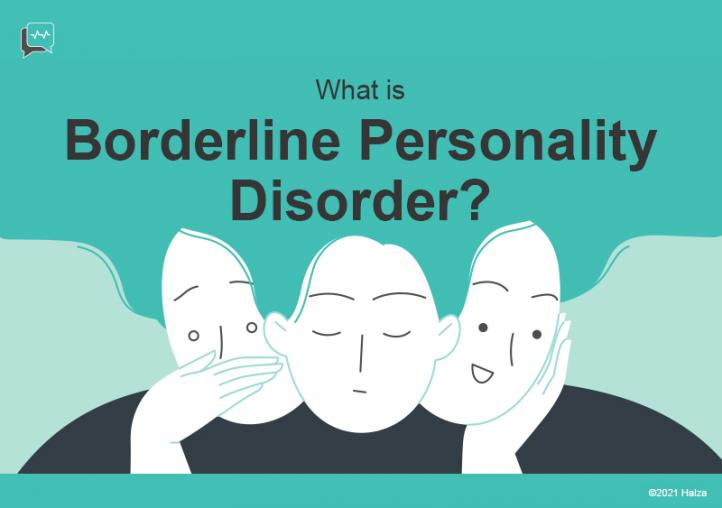What is Borderline Personality Disorder?

Borderline personality disorder (BPD) is a complex mental health disorderthat is marked by dramatic shifts in emotion and mood. Symptoms include difficulties in relationships, an unstable self-image, and fear of abandonment. BPD can range from mild to severe, depending on how much it impacts social and occupational functioning.
A diagnosis of BPD requires five or more of the following criteria in multiple contexts:
- Desperate efforts to avoid real or perceived abandonment.
- A history of unstable, intense relationships in which the person or their relationship is viewed through a lens of extremes: either ideal or horrible.
- A disturbed self-image. For example, in an effort to feel more comfortable with themselves, they might jump from job to job.
- Impulsiveness in at least two potentially self-damaging areas such as: sex with strangers, substance abuse, drunk driving, or binge eating.
- This often happens in an effort to avoid their emotions.
- Recurrent suicidal behavior or threats of suicide; or self-mutilation.
- Intense irritability, anger, or anxiety in reaction to a person or situation, usually lasting for a few hours to (rarely) a few days.
- Chronic feelings of emptiness. Inappropriate, intense anger or difficulty controlling anger.
- Short-term stress-related paranoia
What other disorders are associated with borderline personality disorder?

People with borderline personality disorder often have other psychiatric diagnoses. These include:
- Major depression
- Post-traumatic stress disorder
- Bulimia
- Anorexia nervosa
- Bipolar disorder
- Substance abuse
Because these disorders frequently occur in people with borderline personality disorder, BPD is often misdiagnosed as one of the other disorders, particularly bipolar disorder. Approximately 8-10% of people with borderline personality disorder take their own lives.
Who gets borderline personality disorder, and why?
Doctors don’t know the exact cause of BPD, but it is most likely a combination of a genetic predisposition combined with childhood trauma or another environmental experience. Approximately 1 to 2 out of 100 people have BPD, divided equally between males and females.
Borderline personality disorder is not usually a lifelong disorder. With the right combination of treatment and support, many people with BPD can recover and have long term relationships. Without treatment, a succession of short-term failed relationships is more typical.
What are the treatments for borderline personality disorder?

Therapy:
Dialectical Behavior Therapy (DBT) DBT is the gold standard of treatment for borderline personality disorder. DBT therapists help the patient identify and change harmful thought patterns. In addition, DBT provides skills to help the patient control emotions and tolerate distress.
If DBT is not available, alternatives include:
Psychotherapy (talk therapy), in a group or with a private therapist. The therapist should be experienced in helping people with borderline personality disorder.
Cognitive analytical therapy (CAT)
CAT helps the patient to look at patterns they have in relationships and figure out how to change them.
Mentalization-based therapy (MBT)
MBT helps the patient challenge negative beliefs about what other people might be thinking or feeling.
Therapeutic communities
Therapeutic communities bring together people who are experiencing mental health difficulties. One benefit is that patients can support one another under the guidance of one or more therapists. In most residential communities, patients are expected to attend individual and group therapy and participate in group social activities.
Self-help
Although not a substitute for therapy, some people benefit from learning relaxation techniques and making lifestyle changes to minimize stress.
Medication In the U.S., no medications are approved specifically for BPD. Antipsychotic medications might be prescribed to reduce mood swings, and medicines such as selective serotonin reuptake inhibitors (SSRIs) or anti-anxiolytics might be prescribed for co-occurring conditions such as depression or anxiety.
Hospitalization
Anyone with borderline personality disorder who might harm themselves or someone else should be hospitalized until the crisis has passed.
What does borderline personality disorder feel like?

People with borderline personality disorder are often described as being angry, needy, short-tempered, and/or demanding. It is important to understand that these characteristics come from an intensity of emotion that most of us rarely experience. We typically feel our most intense emotions in response to an event of real significance – perhaps storm damage to our home, our spouse’s request for a divorce, or being injured by a drunk driver. A person with BPD can feel similarly intense emotion in response to a loved one innocently canceling dinner plans.
In a common scenario, they feel abandoned and are angry when their loved one returns home. Later, they feel ashamed that they got so angry. The shame is one more blow to their already low self-esteem. At the same time, they might pivot from feeling angry to feeling happy that their loved one is perfect. They see their loved one as either all good or all bad, with nothing in between.

Image Credit: Presentations & Events | Behavioral Research & Therapy Clinics (washington.edu) by Behavioral Research & Therapy Clinics — University of Washington | Seattle, WA
An excellent description of what it feels like to have borderline personality disorder comes from Marsha Linehan, the creator of DBT. She says “People with BPD are like people with third degree burns over 90% of their bodies. Lacking emotional skin, they feel agony at the slightest touch or movement”.
How to help
If you know someone with borderline personality disorder, try to understand how difficult life can be for them and don’t take their reactions personally. Try to stay calm when they are upset – think of yourself as the ship’s anchor during a storm. Walk away if you need to. If you feel it is appropriate, encourage them (when things are calm) to get professional help. Assure them that you will support them in their efforts to recover.
For more suggestions, see Halza’s article “Having a Successful Relationship With A Person With Borderline Personality Disorder”.
How Halza Can Help:
Manage you and your family’s health easily with the Halza app!
Store, track & share all of your child’s medical records to have them with you, wherever you go. Monitor your child’s growth and vaccination schedule as well as upload reports and doctor’s notes all with the Halza app. QuickShare a complete overview of you or your child’s health with any attending doctor in seconds, during emergencies or whenever you need.
Simplify your health journey with Halza.
Sources: MentalHealth-UK — National Alliance on Mental Health (NAMI) — National Institute of Mental Health